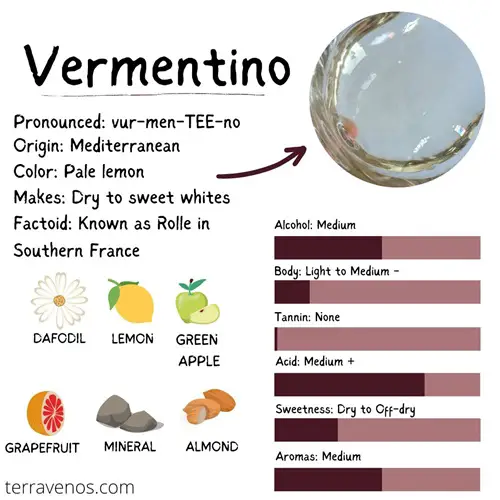
Vermentino (pronounced vur-men-tee-no)
I recently enjoyed a Vermentino as an afternoon aperitif ahead of a large family meal. Our little bottle of Vermentino hailed from Napa, of all places, which was unexpected.
Vermentino, a thin-skinned Italian white grape, is grown in Sardinia, Liguria, Corsica, and Provence (known as Rolle). It shares a high-acid style with Sauvignon Blanc and Pinot Grigio, featuring citrus notes, minerality, and a light body. Pair it with Mediterranean dishes like seafood, salads, and cheese with olives.
Here’s a rundown of Vermentino wine.
- What Is Vermentino Wine?
- Where Is Vermentino Grown?
- Where Is Vermentino Wine Made?
- Is Vermentino Wine Italian?
- What’s Vermentino Wine Taste Like?
- Vermentino vs. Sauvignon Blanc
- Is Vermentino a Chardonnay?
- Is Vermentino Similar to Riesling?
- Vermentino Wine Pairing
- Is Vermentino Good for Cooking?
- Is Vermentino Wine Cheap?
- Can You Age Vermentino?
- How to Serve Vermentino Wine
- Thirsty for More?
What Is Vermentino Wine?
Vermentino is an everyday white table wine made with the white Vermentino grape. It’s not typically blended, but rather made into a single variety white wine. The wine has noticeable acidity, a light body, and refreshing citrus, floral, and almond notes.
Where Is Vermentino Grown?
Vermentino comes from the Mediterranean and has found its way around the coastal regions of western Italy and southern France.
The grape thrives in the hot, sunny summers and temperate wet winters typical of the Mediterranean.
On the Italian mainland in the province of Liguria, Vermentino goes by the name Pigato, where it’s made to make dry wines and sweet passito wines.
Jargon Alert: Passito wines are sweet dessert wines made by allowing the grapes to raisinate before fermentation. This process concentrates the sugars and acids making unctuous dessert wines.
Vermentino’s widely cultivated on the Italian island of Sardinia, where it’s the most important white grape.
The variety grows well on the island which sees over 300 days of sun easy year. You’ll find bottles labeled Vermentino di Sardegna DOC and the higher quality Vermentino di Gallura DOCG.
Jargon Alert: DOC stands for Denominazione di Origine Controllata in Italy. DOC is the second highest quality level – with Denominazione di Origine Controllata meaning “designation of controlled origin”. DOCG wines add a “garantita,” or guarantee, by the Italian government to be wines of especially high quality. Typically, the grapes from these wines come from vineyards known to producer higher quality wines. Check out this helpful post on the Italian DOC system.
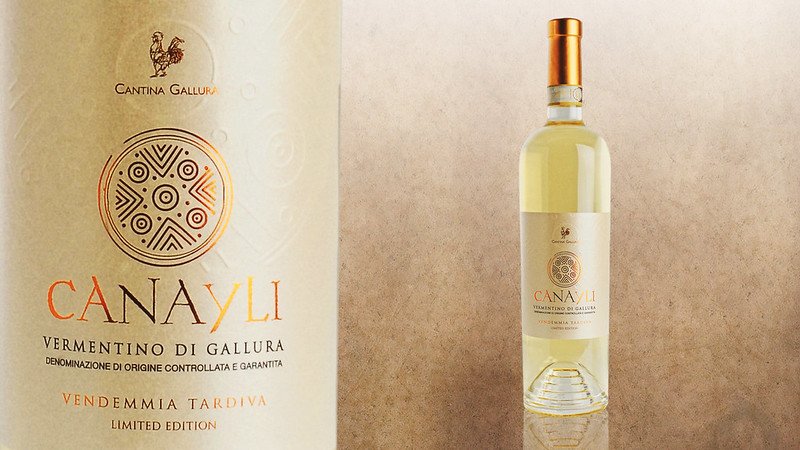
Look for:
- Vermentino di Gallura DOCG – the highest quality level
- Vermentino di Sardegna DOC – the 2nd highest quality level
Fun Wine Fact: Today, Vermentino is also the number one white grape variety grown on the French island of Corsica.
And just across the water, Vermentino’s cultivated in the French region of Provence (see below), where it goes by the local name of Rolle or the more popular Vermentino depending on the producer.
Outside of the Mediterranean, you’ll find small plantings of Vermentino in Australia and California.
The grape hasn’t gained the mainstream popularity of Chardonnay or Sauvignon Blanc, but if you’re for lookinh something new, yet somehow familiar, you’ll find it in a bottle of Vermentino.
Where Is Vermentino Wine Made?
Vermentino’s widely made in Sardinia, Liguria, Corsica, and Provence. You’ll find small boutique production in Australia and California.
There’s limited production of Vermentino in South Africa and Malta.
Is Vermentino Wine Italian?
While the exact origins of the Vermentino grape aren’t known – maybe Spain, maybe Greece – Vermentino’s definitely a Mediterranean grape!
Vermentino is most associated with Italy as the primary white wine of Sardinia and Liguria, but Vermentino’s also the main white grape planted on the French island of Corsica and grows throughout Provence.
What’s Vermentino Wine Taste Like?
Your Vermentino wine taste will be similar to a Sauvignon Blanc or a Pinot Grigio. Think lemon, lime, and minerality.
You may also find green apples, almonds, and white flowers, like daffodils, in your glass of Vermentino.
Tip: Knowing how to taste white wines can be helpful. Here’s a useful post I wrote to get started with tasting white wine flavors.
Vermentino’s are almost always dry with medium-high to high acid, and a light to medium body. You won’t find any tannins in a traditional Vermentino.
Vermentino’s taste profile makes this a refreshing wine for lighter meals or even afternoon sipping.
Patio wine, anyone?
Vermentino vs. Sauvignon Blanc
| Characteristics | Vermentino | Sauvignon Blanc |
|---|---|---|
| Hue | Pale yellow to light green | Pale to light yellow |
| Color | White | White |
| Aromas | Citrus, green apple, herbal | Herbaceous, grassy, citrusy |
| Sweetness | Dry | Dry to off-dry |
| Acid | High | Higher |
| Alcohol (%) | 12-13% | 12-14% |
| Body | Light to medium | Light to medium |
| Intensity | Moderate | Pronounced |
| Key Growing Regions | Italy (Sardinia, Liguria, Tuscany), France (Corsica) | Loire Valley, New Zealand, California |
| Classic Pairings | Seafood, salads, light pasta | Seafood, salads, chicken |
| Price Range | $15-$30 | $10-$30 |
If you ask a wine store clerk what wine is similar to Vermentino, they’ll likely say Sauvignon Blanc.
But is Vermentino like Sauvignon Blanc?
Vermentino often gets compared to Sauvignon Blanc as two higher acid white wines. Both can have citrus flavors, to include lemon, lime, and grapefruit.
Sauvignon Blanc from cooler growing regions, for example, the Loire’s Sancerre or Pouilly-Fumé, can have notes of stone and minerality that you might detect in your Vermentino. Vermentino won’t have the classic gooseberry or passion fruit of Sauvignon Blanc, but is more likely to have green apple and daffodil.
Vermentino doesn’t tend to be as aromatic as Sauvignon Blanc, either, but both wines are excellent choices and trying a Vermentino instead of your typical Sauvignon Blanc is sure to be a refreshing change.
Helpful Tip: Here’s a guide to Sauvignon Blanc wines if you’re curious.
Is Vermentino a Chardonnay?
| Characteristics | Vermentino | Chardonnay |
|---|---|---|
| Hue | Pale yellow to light green | Pale to deep gold |
| Color | White | White |
| Aromas | Citrus, green apple, herbal | Apple, pear, tropical fruit |
| Sweetness | Dry | Range from dry to off-dry |
| Acid | High | Moderate to high |
| Alcohol (%) | 12-13% | 12-15% |
| Body | Light to medium | Medium to full |
| Intensity | Moderate | Moderate to pronounced |
| Key Growing Regions | Italy (Sardinia, Liguria, Tuscany), France (Corsica) | France (Burgundy, Champagne), USA (California) |
| Classic Pairings | Seafood, salads, light pasta | Poultry, seafood, creamy dishes |
| Price Range | $15-$30 | $10-$50 |
No, Vermentino isn’t a Chardonnay. Chardonnay and Vermentino are distinct and separate grape varieties. Chardonnay and Vermentino may share similar taste profiles with citrus notes – lemon, lime, grapefruit – and maybe even green apple flavors, but Chardonnay tends to be less aromatic than Vermentino while Vermentino brings a mineral and floral note to white wines you don’t often find in Chardonnay.
Helpful Tip: Go Check out this post on Chardonnay wines (a personal favorite).
Is Vermentino Similar to Riesling?
| Characteristics | Vermentino | Riesling |
|---|---|---|
| Hue | Pale yellow to light green | Pale to golden yellow |
| Color | White | White |
| Aromas | Citrus, green apple, herbal | Stone fruits, floral, petrol |
| Sweetness | Dry | Range from bone dry to sweet |
| Acid | High | High |
| Alcohol (%) | 12-13% | 7-13% |
| Body | Light to medium | Light |
| Intensity | Moderate | Moderate to pronounced |
| Key Growing Regions | Italy (Sardinia, Liguria, Tuscany), France (Corsica) | Germany, Alsace (France), Austria |
| Classic Pairings | Seafood, salads, light pasta | Asian cuisine, spicy dishes, cheese |
| Price Range | $15-$30 | $10-$40 |
Vermentino and Riesling do share several similar qualities. They are both higher-acid white wines with citrus notes. They can both be lighter-bodied wines, too. However, Riesling tends to be more aromatic with floral and petrol notes; Vermentino has less complexity overall. Rieslings can age; Vermentino should be enjoyed within a few years of bottling.
Tip: Here’s a curious post about Riesling wine if you want to explore more.
Vermentino Wine Pairing
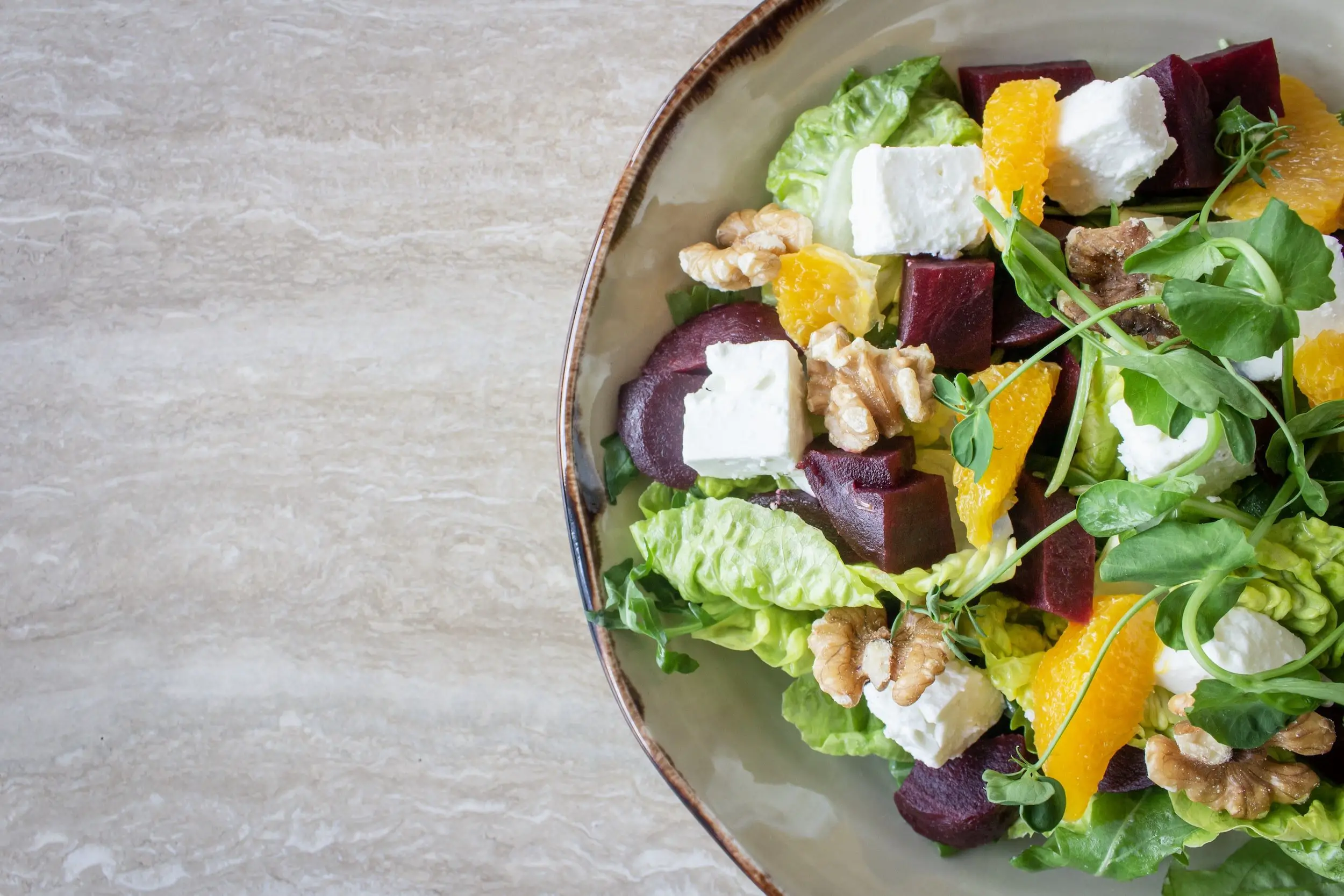
Vermentino calls the Mediterranean its ancestral home, so look for Mediterranean cuisine to pair with your Vermentino wine.
Seafood dishes like herbed fish, grilled octopus, and sardines will compliment the wine’s acidity.
If you’re looking for an afternoon sipping wine, then Vermentino is your go-to gal. Pair her up with an olive tray, charcuterie, and crudites.
Add some warm pita bread and hummus or some herbed crackers to round out your party tray.
Pairing Tip: In general, high acid wines will cut through fat and grease, helping to cleanse your palate. Whether you’re thinking about pairing Vermentino, Sauvignon Blanc, or Pinot Grigio, these high-acid wines will typically pair well with fried or fatty foods. Think about low-stress pairings as simple as fried chicken, potato chips, or french fries – all will work well. Check out 6 simple steps to pair food and wine every time here.
Winning Vermentino Pairings
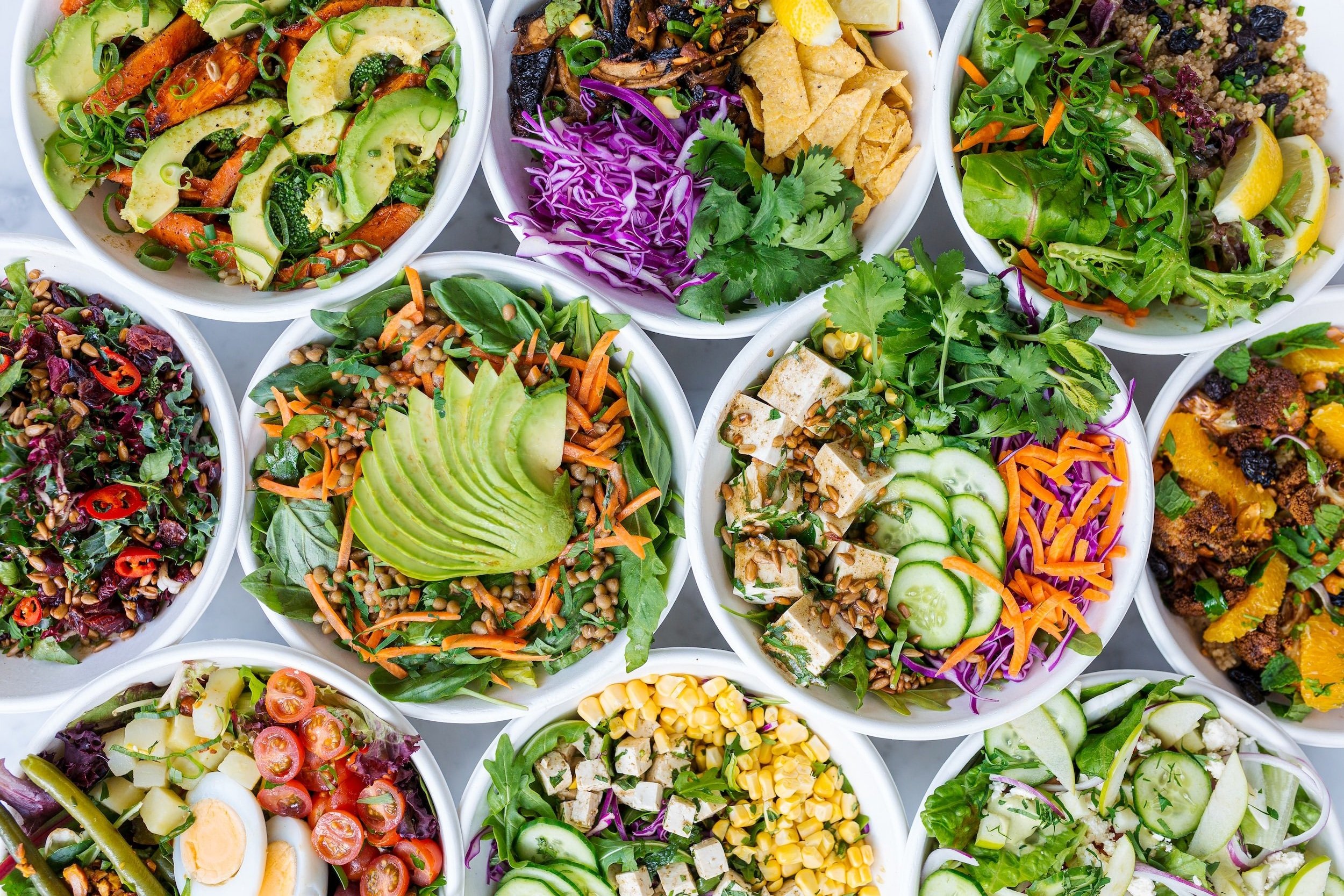
- Grilled white fish
- Herb roasted chicken
- Risottos
- Roasted vegetables with olive oil
- Vegetable tempura
- Green salads with Italian dressing
- Goat cheese and almonds
- Pita and hummus
- Potato chips (always a winner)
- Creamy or broth-based chicken soup
Helpful Tip: If you’re just getting started out with wine, I put together this helpful overview of food with wine pairing to get you started. Side note – I spend just as much time thinking about food with wine pairing as I do deciding what I’m going to eat every night. Utter hedonism. What can I say?
Is Vermentino Good for Cooking?
If you find yourself with a half-bottle of leftover Vermentino or are thinking about substituting Vermentino for a recipe that calls for white wine, then go for it!
Vermentino’s high acid and citrus profile make it a perfect substitute for any recipe that calls for white wine, be it sauces, soups, gravies, or sautees.
Is Vermentino Wine Cheap?
One of the best things about Vermentino wine is its affordability. You can find decent, 90+ point Vermentinos for under $20 USD (as of 2022).
Expect to pay between $10USD – $20 USD for an imported Vermentino from Sardinia, which offers phenomenal value for quality. Super premium Vermentino, for example, Capichera Santigaini Vermentino Isola dei Nuraghi, can fetch over $120 USD/bottle.
Tip: Wines come in a variety of price points and quality levels. Check out this useful post I wrote to understand how to pick a good grocery store wine that explains how bottle pricing and quality work.
Can You Age Vermentino?
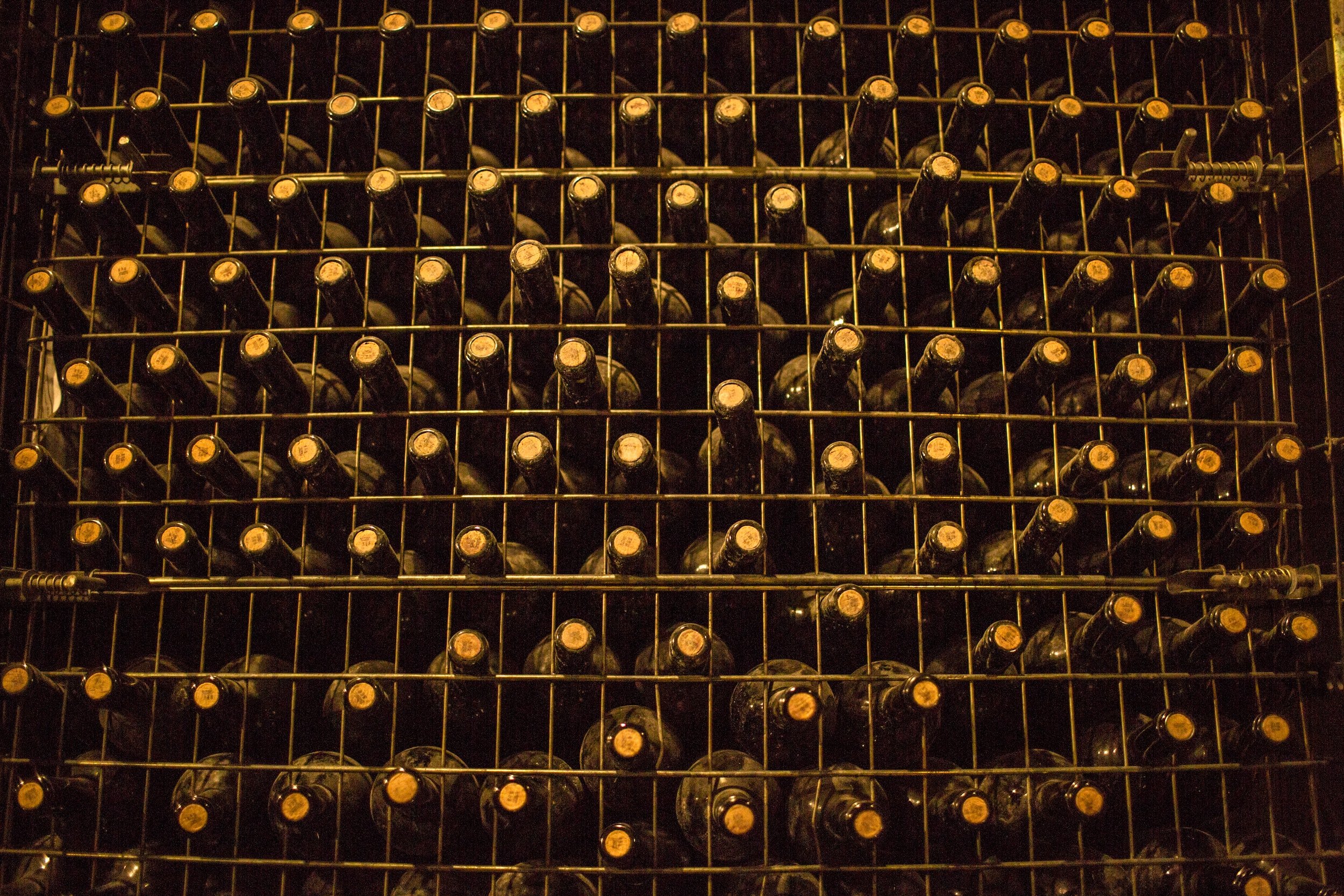
Vermentino is a white table wine. Most Vermentinos will lack the flavor and aroma concentration to allow them to age gracefully in the bottle for more than a few years. If you buy a bottle of Vermentino (which you absolutely should), then plan on drinking it sooner rather than later.
If you see two Vermentinos on the store shelf and one of them is younger than the other, grab the younger bottle.
Vermentino is a great example of only aging a bottle of wine for as long as it takes you to get home from the bottle shop!
Don’t age Vermentino for more than 2 years in your cellar.
How to Serve Vermentino Wine
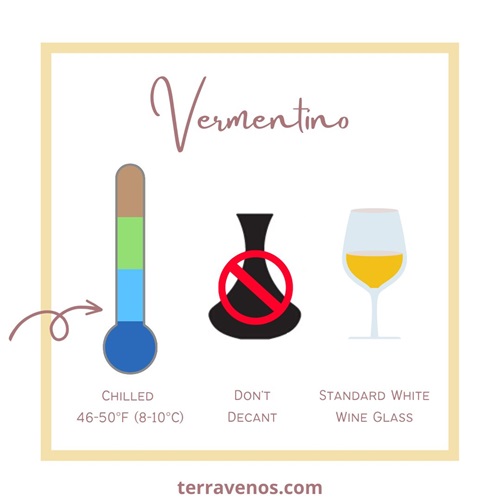
Serve your Vermentino wine chilled. The ideal temperature to serve Vermentino is between 8 and 10°C (46 and 50°F).
In the real world, this means chilling down your bottle of Vermentino in the refrigerator and then taking the bottle out about 15 – 20 minutes before pouring.
Thirsty for More?
If you’re busy exploring less well-known wines, I highly suggest DIY wine flights – this is probably the best way to learn about wines. Check out this post I put together to get you started with wine flights.
Aaaand… if you’re into finding obscure wines, here’s a fun list of wine grapes A to Z – how many do you know?



